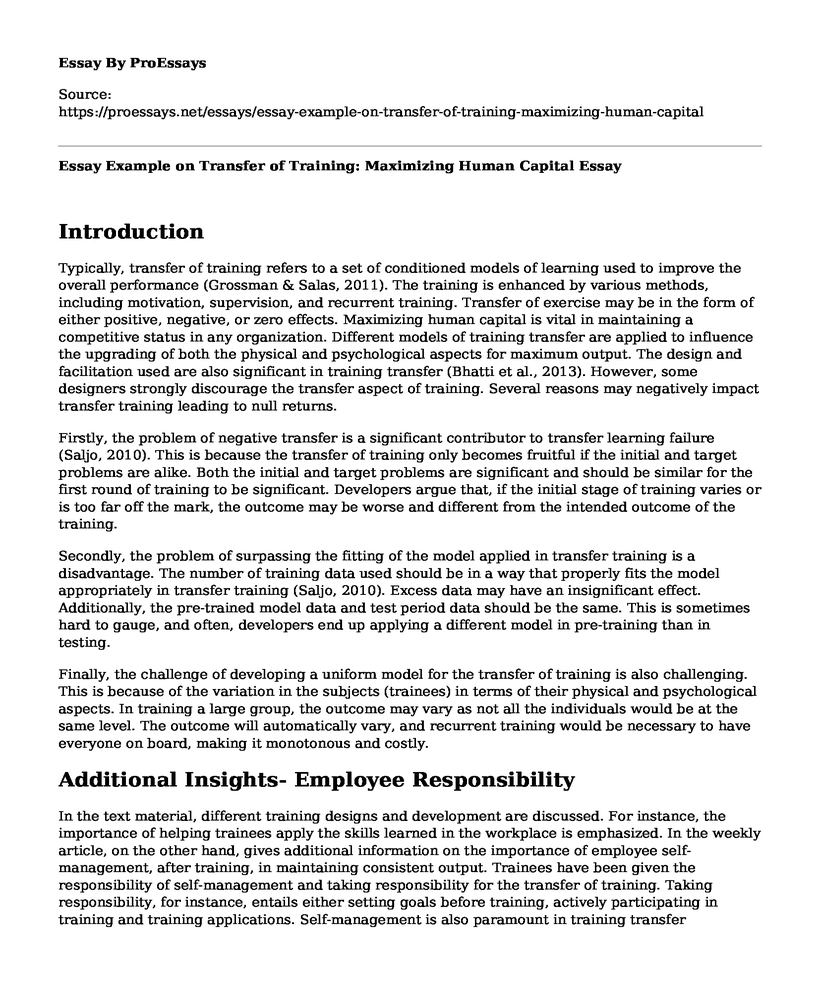Introduction
Typically, transfer of training refers to a set of conditioned models of learning used to improve the overall performance (Grossman & Salas, 2011). The training is enhanced by various methods, including motivation, supervision, and recurrent training. Transfer of exercise may be in the form of either positive, negative, or zero effects. Maximizing human capital is vital in maintaining a competitive status in any organization. Different models of training transfer are applied to influence the upgrading of both the physical and psychological aspects for maximum output. The design and facilitation used are also significant in training transfer (Bhatti et al., 2013). However, some designers strongly discourage the transfer aspect of training. Several reasons may negatively impact transfer training leading to null returns.
Firstly, the problem of negative transfer is a significant contributor to transfer learning failure (Saljo, 2010). This is because the transfer of training only becomes fruitful if the initial and target problems are alike. Both the initial and target problems are significant and should be similar for the first round of training to be significant. Developers argue that, if the initial stage of training varies or is too far off the mark, the outcome may be worse and different from the intended outcome of the training.
Secondly, the problem of surpassing the fitting of the model applied in transfer training is a disadvantage. The number of training data used should be in a way that properly fits the model appropriately in transfer training (Saljo, 2010). Excess data may have an insignificant effect. Additionally, the pre-trained model data and test period data should be the same. This is sometimes hard to gauge, and often, developers end up applying a different model in pre-training than in testing.
Finally, the challenge of developing a uniform model for the transfer of training is also challenging. This is because of the variation in the subjects (trainees) in terms of their physical and psychological aspects. In training a large group, the outcome may vary as not all the individuals would be at the same level. The outcome will automatically vary, and recurrent training would be necessary to have everyone on board, making it monotonous and costly.
Additional Insights- Employee Responsibility
In the text material, different training designs and development are discussed. For instance, the importance of helping trainees apply the skills learned in the workplace is emphasized. In the weekly article, on the other hand, gives additional information on the importance of employee self-management, after training, in maintaining consistent output. Trainees have been given the responsibility of self-management and taking responsibility for the transfer of training. Taking responsibility, for instance, entails either setting goals before training, actively participating in training and training applications. Self-management is also paramount in training transfer execution. The trainees are taught on how to self-manage themselves and apply the skills learned without close or constant supervision. Some of the areas of self-management include; application of the newly learned skills, setting of goals, self-motoring, and assessment of the progress of skills, and determining the appropriate mode of execution of the skill at the place of work.
According to Noe et al. (2015), trainees who have been taught self-management display a high degree of the skills acquired in a transfer of training than those supervised. Under self-management, the trainee can go through several work obstacles and tackle them appropriately. This helps in modeling the trainee and crediting of transfer of training. Facing such challenges earlier and alone help in quickly understanding the reality of the work and various ways of maneuvering. Such challenges may include either work pressure, lack of colleague support, among others. Being able to thrive in such conditions is an exhibition of taken responsibility and proper management of oneself. Thus, trainee responsibility and self-management are crucial in the success of the training design and development models.
References
Grossman, R., & Salas, E. (2011). The transfer of training: what matters. International Journal of Training and Development, 15(2), 103-120.
Bhatti, M. A., Battour, M. M., Sundram, V. P. K., & Othman, A. A. (2013). Transfer of training: does it truly happen?. European Journal of Training and Development.
Saljo, R. (2010). Digital tools and challenges to institutional traditions of learning: technologies, social memory, and the performative nature of learning. Journal of computer assisted learning, 26(1), 53-64.
Noe, R. A., Hollenbeck, J. R., Gerhart, B., & Wright, P. M. (2015). Human resource management. Gaining a Competitive.
Cite this page
Essay Example on Transfer of Training: Maximizing Human Capital. (2023, Apr 06). Retrieved from https://proessays.net/essays/essay-example-on-transfer-of-training-maximizing-human-capital
If you are the original author of this essay and no longer wish to have it published on the ProEssays website, please click below to request its removal:
- Essay on Human Performance Technology Model
- Paper Example on Work-Related Challenges: Think and Problem Solving
- Distribution of Fruit Juice Paper Example
- How Does Stress Affect the Productivity of Interpreter? - Research Paper
- Maximizing Employee Performance: The Relationship Between Workplace Spirituality & Organizational Effectiveness
- Motivating Employees: Leadership, Focus, and Persistence - Essay Sample
- Essay Sample on Ford Motor: Committed to Team-Based Automotive Manufacturing







